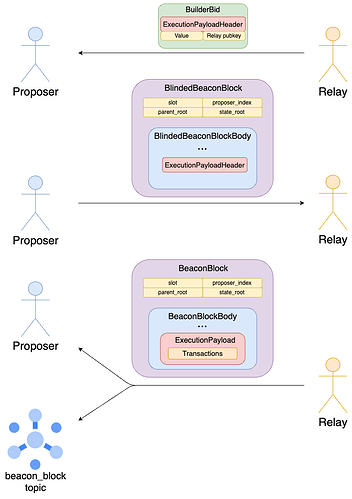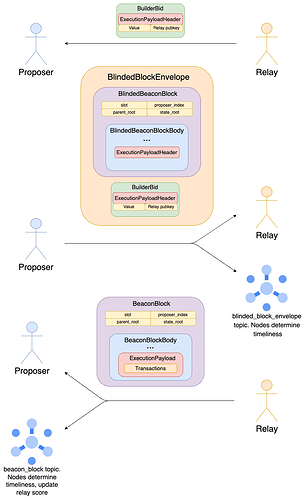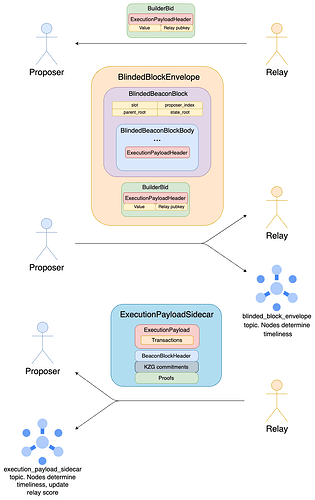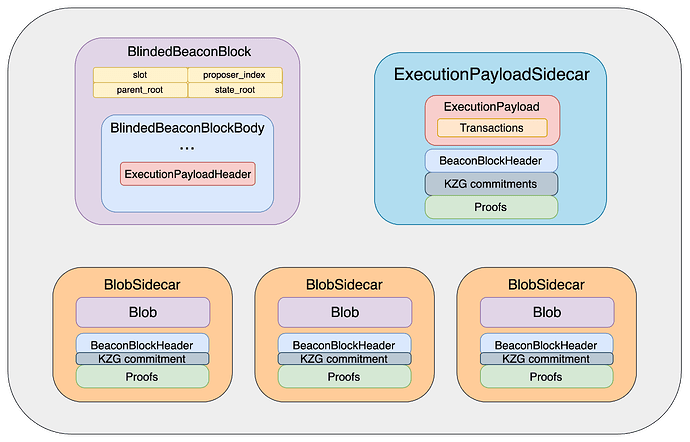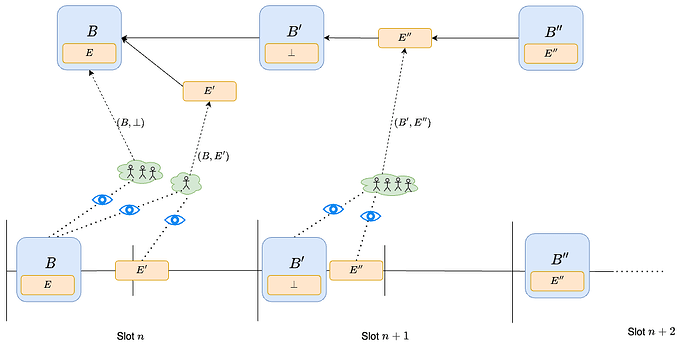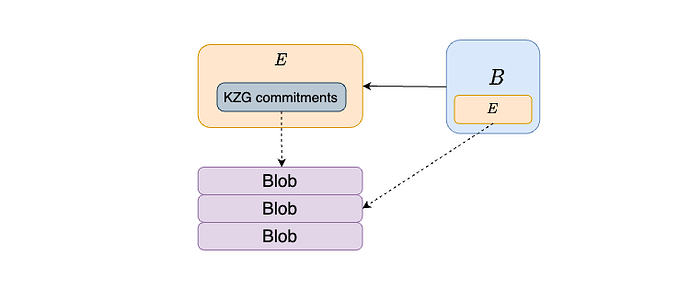Thanks to Alex Stokes, Anders Elowsson and Potuz for feedback
The goal of this post is to explore some ways we can improve the guarantees of PBS as it currently exist in Ethereum, as an alternative to full enshrinement, which risks prematurely committing to a solution that is far from being universally recognized as the right one.
We first discuss a relatively small change to the status quo, which introduces a gossip topic to observe part of the mev-boost auction, allowing validators to reliably keep track of relay performance and disconnect from specific relays if necessary.
We then discuss some potential deeper changes to the protocol, which still fall short of full epbs enshrinement, with the goal of allowing beacon blocks to exist even without execution payloads, so that a mev-boost failure affects the progress of the EL but not the CL.
Observing the exchange: hardening mev-boost through gossip
Basics of the mev-boost exchange
The builder specs define a bid object to be sent from a relay to a connected validator. It contains a bid value, the pubkey of the relay and the ExecutionPayloadHeader corresponding to the ExecutionPayload that the builder intends to sell to the validator.
class BuilderBid(Container):
header: ExecutionPayloadHeader
value: uint256
pubkey: BLSPubkey
class SignedBuilderBid(Container):
message: BuilderBid
signature: BLSSignature
The specs also define a blinded version of the BeaconBlock, in which the ExecutionPayload is substituted with an ExecutionPayloadHeader. Most notably, the transactions field in the former is replaced by transactions_root in the latter, so that transactions are not revealed to the proposer before it commits to a specific payload. After choosing a winning SignedBuilderBid, the proposer initiates the exchange by responding with a SignedBlindedBeaconBlock.
class BlindedBeaconBlockBody(Container):
randao_reveal: BLSSignature
eth1_data: Eth1Data
graffiti: Bytes32
proposer_slashings: List[ProposerSlashing, MAX_PROPOSER_SLASHINGS]
attester_slashings: List[AttesterSlashing, MAX_ATTESTER_SLASHINGS]
attestations: List[Attestation, MAX_ATTESTATIONS]
deposits: List[Deposit, MAX_DEPOSITS]
voluntary_exits: List[SignedVoluntaryExit, MAX_VOLUNTARY_EXITS]
sync_aggregate: SyncAggregate
# Replacing full Execution_Payload
execution_payload_header: ExecutionPayloadHeader
class BlindedBeaconBlock(Container):
slot: Slot
proposer_index: ValidatorIndex
parent_root: Root
state_root: Root
# Replacing BeaconBlockBody
body: BlindedBeaconBlockBody
class SignedBlindedBeaconBlock(Container):
message: BlindedBeaconBlock
signature: BLSSignature
The relay reconstructs the full SignedBeaconBlock by substituting the ExecutionPayloadHeader with the ExecutionPayload in the SignedBlindedBeaconBlock, and validates it. If successful, it releases it, completing the exchange.
The Signed containers are omitted in the diagram for ease of exposition, and so are the blob sidecars.
Observing the exchange
Currently, nodes can observe the second part of the exchange, i.e., the publication of the SignedBeaconBlock, but not the first part. If they could observe the first part, i.e., the proposer sending theSignedBlindedBeaconBlock to the relay, they would have observability into the full exchange between proposer and relay. If a node observes a unique, valid SignedBlindedBeaconBlock sufficiently in advance of the attestation deadline, it knows that the relay/builder has enough time to receive it, validate it and propagate the full SignedBeaconBlock. In other words, the proposer has fulfilled its half of the exchange. Were the slot to be missed, the node can then reasonably attribute the failure to the relay. If instead it does not observe a timely, valid SignedBlindedBeaconBlock, or observes multiple, it can attribute any eventual failure to the proposer: it is ok for the relay to withhold the ExecutionPayload when it cannot be reasonably sure of the outcome of publishing it, i.e., whether or not the corresponding BeaconBlock will become part of the canonical chain.
Independent validation of a blinded beacon block
Firstly, we need to clarify what it means for a SignedBlindedBeaconBlock to be valid independently of the full ExecutionPayload whose header it contains. Currently, the beacon chain state transition involves the execution payload in a few ways:
process_execution_payloadchecks thatpayload.parent_hash,payload.prev_randao,payload.timestampare correct, and updatesstate.latest_execution_payload_headerto the newExecutionPayloadHeader.process_withdrawalschecks thatpayload.withdrawals == get_expected_withdrawals(state), to ensure that the same withdrawals are processed by EL and CL.- the EL is called to verify the
ExecutionPayload
Everything in 1. involves only the ExecutionPayloadHeader, because parent_hash, prev_randao and timestamp are fully contained in it as well. While 2. involves the full payload as written in the spec, we can instead useexecution_payload_header.withdrawals_root, i.e.,hash_tree_root(payload.withdrawals), and check withdrawals_root = hash_tree_root(get_expected_withdrawals(state)). Finally, we are not concerned with 3: if we observe aSignedBlindedBeaconBlock which satisfies checks 1. and 2. sufficiently in advance of the attestation deadline, we know that whether the builder is able to release a valid SignedBeaconBlock entirely depends on whether they have made a valid ExecutionPayload.
Future compatibility: EIP-7002 and EIP-6110 introduce more message passing from the EL to the CL, i.e., EL-triggered exits and deposits. An ExecutionPayload would contain fields execution_layer_exits and deposit_receipts, which contain operations to be processed by the CL state transition. Clearly, such processing cannot happen in a BlindedBeaconBlock as currently constructed, because those fields would be replaced by execution_layer_exits_roots and deposit_receipts_root. As might happen in the builder specs, the ExecutionPayloadHeader in the BlindedBeaconBlock could be replaced by a BlindedExecutionPayload, where only the transactions field is replaced by transactions_root, while withdrawals, execution_layer_exits,deposit_receipts (and any other necessary fields that might be added in the future) are kept fully. Note that a BlindedBeaconBlock constructed this way still has the same hash_tree_root as the full BeaconBlock.
Gossiping signed blinded beacon blocks
To gain observability into the first part of the exchange, we can create a GossipSub topic, blinded_block_envelope, joined by nodes which run mev-boost. Only the current proposer would be able to publish to the topic, and it would publish this signed envelope:
class BlindedBlockEnvelope(Container):
signed_builder_bid: SignedBuilderBid
signed_blinded_beacon_block: SignedBlindedBeaconBlock
class SignedBlindedBlockEnvelope(Container):
message: BlindedBlockEnvelope
signature: BLSSignature
Here we include the SignedBuilderBid in the envelope, instead of just gossiping a SignedBlindedBeaconBlock, to ensure that failures are attributable to the relay which has signed this bid.
Relay scoring
Every validator in the topic would then observe the arrival time of this object, as well the outcome of the slot, and use these data points to inform whether or not it should stay connected to the relay with pubkey signed_builder_bid.message.pubkey. For example, a client might choose to enact a simple strategy like this one:
- if a valid
signed_blinded_block_envelopeis received before 2.5s but the slot is missed, downscore the relay by D, up until 0, unless an equivocation from the proposer is detected. - if a relay successfully lands a block on chain, increase the relay score by D/100, up until the maximum score S_{max}.
- if the relay score is < S_{min}, disconnect from the relay.
If a relay is failing to land more than 1% of blocks when the SignedBlindedBeaconBlock has been timely propagated, validators will quickly disconnect it, and they will only reconnect either manually or if the relay lands a lot of blocks without accidents. If most validators have initially disconnected from it, landing enough blocks for automatic reconnection would likely need many validators to first manually reconnect. This might for example be the case if a relay experiences a bug or some other non-malicious failure which is sufficiently investigated that validators feel comfortable reconnecting to it. In this case, even the validators that are not plugged in to the off-chain process can eventually reconnect.
Again, the Signed containers are omitted in the diagram for ease of exposition, and so are the blob sidecars. Note also that we do not need to include the ExecutionPayloadHeader twice.
Avoiding redundant propagation
In the above, theSignedBlindedBeaconBlock and SignedBeaconBlock are gossiped separately, though they mostly overlap. This might be ok in practice, since the SignedBlindedBeaconBlock has a fairly small maximum size (about 160 KBs according to this, and should not have changed too much since). Still, we could in principle split up the propagation of the SignedBlindedBeaconBlock and of the ExecutionPayload into two topics to avoid any redundancy:
- We would change the message type of the
beacon_blocktopic fromSignedBeaconBlocktoSignedBlindedBeaconBlockEnvelope. A proposer who builds locally would setsigned_builder_bid = Nonein theBlindedBeaconBlockEnvelope, effectively just gossiping aSignedBlindedBeaconBlock. - We add another topic,
execution_payload_sidecar, whose message type isExecutionPayloadSidecar, which, much like aBlobSidecar, comes with aSignedBeaconBlockHeaderand a merkle inclusion proof against it. Moreover, like aDataColumnSidecar, it comes with a list ofkzg_commitments,kzg_proofsand akzg_commitment_inclusion_proof. This allows theversioned_hashesto be computed, so that anewPayloadRequestmay be sent to the EL for verification without waiting for the full beacon block. Gossip validation requires verifying all proofs and performing all checks prescribed by the bellatrix spec.
class ExecutionPayloadSidecar(Container):
execution_payload: ExecutionPayload
signed_block_header: SignedBeaconBlockHeader
kzg_commitments: List[KZGCommitment, MAX_BLOB_COMMITMENTS_PER_BLOCK]
kzg_proofs: List[KZGProof, MAX_BLOB_COMMITMENTS_PER_BLOCK]
kzg_commitments_inclusion_proof: Vector[Bytes32, KZG_COMMITMENTS_INCLUSION_PROOF_DEPTH]
execution_payload_inclusion_proof: Vector[Bytes32, EXECUTION_PAYLOAD_INCLUSION_PROOF_DEPTH]
Since the ExecutionPayloadSidecar comes with an inclusion proof, it can be gossiped independently of the SignedBlindedBeaconBlockEnvelope. Moreover, the ExecutionPayload and the SignedBlindedBeaconBlock can be fully verified independently of one another (using the extra information in the sidecar to verify the payload), and successful verification of both guarantees that the finalSignedBeaconBlock is valid. In other words, both propagation and verification can happen in parallel.
Note that in this diagram we are depicting the flow while using mev-boost, and again ignoring signed containers and blob sidecars. For local block-building, a proposer propagates all objects in parallel, as is already the case for blob sidecars. Alternatively, the could keep the local block-building path unchanged, by still allowing propagation of full beacon blocks.
Exploration: Insulating Beacon blocks from execution failures
Currently, a relay failure leads to a missed slot, even if the proposer constructs their BlindedBeaconBlock correctly. That’s still the case in the previous section: a BlindedBeaconBlock can be gossiped and validated separately from theExecutionPayload it commits to (by containing a specific ExecutionPayloadHeader), but the ExecutionPayload must still be available and valid in order for the block to count. Here we begin to explore the space of solutions to this specific problem, while not attempting to solve the many other issues that more complete solutions like epbs or execution tickets concern themselves with. The goal is to see how much we can get with as few changes as possible.
Delayed payload inclusion
We do not require a BeaconBlock to commit to a new ExecutionPayload at all. Instead, aBeaconBlock contains and processes the ExecutionPayload proposed alongside its parent, if any. In other words, a payload is included by the first beacon block that comes after it.
The proposer is free to publish a BeaconBlock as soon as it wants (without needing to play any timing games), and to later publish (by itself or through mev-boost) a compatible ExecutionPayload, without this affecting the BeaconBlock at all. If theExecutionPayload turns out to be late, unavailable or invalid, the next proposer will simply make a BeaconBlock without a payload.
Attestation and fork-choice changes
We augment attestations with an execution_payload_root, allowing attesters to express which (if any) ExecutionPayload they have observed:
class AttestationData(Container):
slot: Slot
index: CommitteeIndex
# LMD GHOST vote
beacon_block_root: Root
execution_payload_root: Root # New
# FFG vote
source: Checkpoint
target: Checkpoint
The attestation and fork-choice behavior is changed as follows:
execution_payload_rootis set toNoneif no payload has been observed, and tohash_tree_root(execution_payload)otherwise, whereexecution_payloadis the first one received.- Given a
BeaconBlockB and anExecutionPayloadE built on B, E is considered a child of B in the fork-choice tree, meaning all weight from votes (B,E) accrues to both E and B. Here by (B,E) we simply mean an attestation withbeacon_block_root = hash_tree_root(B)andexecution_payload_root = hash_tree_root(E).
- The head of the chain might be a
BeaconBlock, if there is no associatedExecutionPayloadextending it. In this case, the next proposer makes aBeaconBlockwithout anExecutionPayload(\perp in the figure above). If there is anExecutionPayloadbut it does not have much fork-choice weight itself, the proposer can still choose to ignore theExecutionPayloadand make aBeaconBlockwithout one, using proposer-boost to convince others to follow its choice. This behavior is exactly the same as late-block reorging today.
In the diagram, B is proposed early, while payload E' very close to the attestation deadline, so that many validators do not see it on time and vote for (B, \perp). Since there are not a lot of votes for (B,E'), the next proposer uses proposer-boost to reorg E', by proposing block B' with empty payload. On the other hand, B' extends B, since all votes from the previous slot are either for (B,\perp) or (B,E'), all contributing weight to B. Moreover, payload E'' is also proposed on time, and all attesters vote for (B', E''). Therefore, the next proposer (or anyway the first proposer to make a block afterwards) has no choice but to extend E'', meaning their beacon block B'' contains and processes payload E''.
Cross-layer interactions
Empty payload
When a beacon block does not contain a payload, it simply acts as a pre-merge block, skipping process_withdrawals, process_execution_payload and other EL ↔ CL operations, such process_execution_layer_exits and process_deposit_receipts (EIP-7002 and EIP-6110).
EL → CL
When a beacon block contains a payload, EL → CL operations like execution_layer_exits and deposit_receipts are handled just as they would today: a beacon block simply executes the operations contained in its payload. In the diagram below, B' would process the exits and deposits contained in E', and B those from E.
CL → EL
Handling CL → EL messages like withdrawals requires a bit more care. We can do it as follows:
- We add to the Beacon State
latest_withdrawals_root, storing a commitment to the last batch of withdrawals which has already been processed by the CL and must now be processed by the next payload. - In a beacon block with a payload,
process_withdrawalschecks thathash_tree_root(payload.withdrawals) == state.latest_withdrawals_root, i.e., that the EL is indeed processing the withdrawals it should. - At this point, both the CL and EL side of the withdrawals which
state.latest_withdrawal_rootcommits to has been processed, so the Beacon State can forget about this commitment.process_withdrawalsmoves on to the next batch, by settingstate.latest_withdrawals_root = hash_tree_root(get_expected_withdrawals(state))and processing the CL side of these withdrawals.
In the situation of the previous diagram, B processes the CL side of the withdrawals determined by its state, i.e., get_expected_withdrawals(state_B), just like today. What changes is that E does not process the EL side of those withdrawals, which instead happens in E'. B' ensures that this is the case, by checking that the withdrawals in E' match state.latest_withdrawals_root, as set by B.
def process_withdrawals(state: BeaconState, payload: ExecutionPayload) -> None:
assert hash_tree_root(payload.withdrawals) = state._latest_withdrawals_root
next_withdrawals = get_expected_withdrawals(state)
state.latest_withdrawals_root = hash_tree_root(next_withdrawals)
for withdrawal in next_withdrawals:
decrease_balance(state, withdrawal.validator_index, withdrawal.amount)
# Update the next withdrawal index if this block contained withdrawals
if len(next_withdrawals) != 0:
state.next_withdrawal_index = WithdrawalIndex(next_withdrawals[-1].index + 1)
# Update the next validator index to start the next withdrawal sweep
if len(next_withdrawals) == MAX_WITHDRAWALS_PER_PAYLOAD:
# Next sweep starts after the latest withdrawal's validator index
next_validator_index = ValidatorIndex((state.next_withdrawals[-1].validator_index + 1) % len(state.validators))
state.next_withdrawal_validator_index = next_validator_index
else:
# Advance sweep by the max length of the sweep if there was not a full set of withdrawals
next_index = state.next_withdrawal_validator_index + MAX_VALIDATORS_PER_WITHDRAWALS_SWEEP
next_validator_index = ValidatorIndex(next_index % len(state.validators))
state.next_withdrawal_validator_index = next_validator_index
Blobs
We can move thekzg_commitments from the BeaconBlockBody to the ExecutionPayload. Beacon blocks without a payload do not come with any kzg commitments. A payload, and a beacon block extending it (containing it) is only considered in the fork-choice tree if the blobs it commits to are available.
Pipelining
We can change the slot structure by adding an explicit new phase for propagation of execution payloads:
- 0s: publish beacon block
- 3s: publish execution payload
- 6s: attestation deadline
- 9s: publish aggregates to global topic
The protocol cannot enforce that the payload should be published at 3s, but crucially there is no reason to:
- publish the beacon block later: the earlier it is published, the less likely it is to be reorged
- publish the payload earlier: the later it is published, the more MEV can be collected (see timing games)
Therefore, we would expect beacon blocks and execution payloads to be published quite far apart from each other, leaving plenty of time for the beacon block to be propagated and processed before the payload needs to be.
